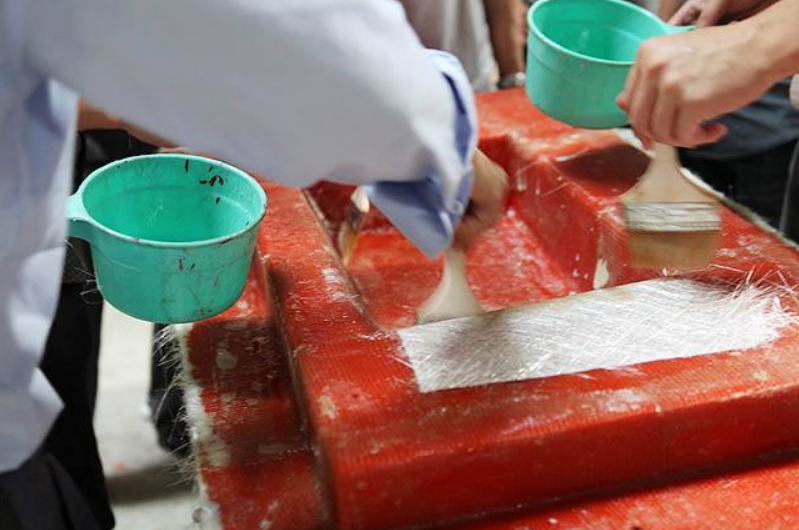Setting up a rubber coating layer on the surface of fiberglass boats
 Jul 12, 2023|
Jul 12, 2023| View:276
View:276Fiberglass boats have a gel coatlayer on the surface, which is equivalent to the paint on the exterior of steel boats, serving the purposes of beautification and aging prevention.

When creating the gel coat layer on the mold, two points should be taken into consideration: first, the gel coat resin should be evenly applied, and second, the thickness should be controlled at 0.35mm (during mold production, the thickness should be appropriately increased due to surface grinding and polishing, with a maximum thickness of 0.8mm). If the layer is too thin, it can be easily worn out and fails to serve its purpose of beautification and aging prevention. On the other hand, if the layer is too thick, it reduces toughness and can lead to cracks and other issues under stress.
There are two methods for applying the gel coat layer: manual brushing and mechanical spraying. Manual brushing involves using a specialized brush with a thinner and firmly rooted bristle (commonly known as a fiberglass brush, but it is actually a gel coat brush) to apply the prepared gel coat resin onto the mold. Mechanical spraying requires dedicated spray guns and spraying machines. The construction essentials are explained below.
(1) Key points for manual brushing:
1、Apply a certain amount of force during brushing to ensure that the gel coat resin adheres tightly to the mold surface, without trapping air. This prevents the formation of surface defects such as bubbles and pinholes.
2、After applying the gel coat, use the brush to evenly distribute and smooth out the layer thickness.
3、The gel coat layer should be applied in two coats to achieve a more uniform thickness. The first coat should be the main coat with a thickness exceeding half of the total, while the second coat serves as a supplemental layer.
4、When applying the second coat, it should be done after the first coat of gel coat resin has solidified to a certain degree to avoid issues like wrinkling. Similarly, the application of the fiberglass layer should only be done after the second coat of gel coat resin has reached the appropriate level of curing.
5、To ensure that the gel coat layer thickness falls within the control range, the quantity can be calculated based on the mold's surface area. For example, with a gel coat layer thickness of 0.4mm, the gel coat resin consumption per square meter of mold area would be 0.4mm x 1.2kg = 0.48kg. Taking into account losses and other factors, it can be rounded up to 0.5kg/m² for preparation (1.2 represents the gel coat resin quantity per millimeter thickness of the gel coat layer).
6、Avoid applying excessive thickness in sharp corners to prevent detachment from the mold due to excessive shrinkage during curing.
(2) Key points for mechanical spraying:
1、Specialized gel coat resin must be used for spraying, which has lower viscosity compared to the resin used for manual brushing. The thixotropic index is 57. (If using the gel coat resin intended for manual brushing, 5% styrene should be added to adjust the viscosity).
2、The compressed air pressure is usually within the range of 3-7 bar and can be adjusted according to equipment requirements.
3、The nozzle diameter should be between 0.35mm and 0.5mm.
4、Maintain a distance of 300-400mm between the nozzle and the mold. Being too close may cause splashing, while being too far will result in scattered spraying.
5、The pressure, nozzle diameter, and spraying efficiency can be adjusted through experimentation. Typically, the spraying efficiency should be around 700-800g/min. For example, with a nozzle diameter of 0.37mm, achieving a wind pressure of 5 bar would yield the aforementioned spraying efficiency.
6、During spraying, horizontal movements on the plane should be the main focus, with each pass overlapping by approximately 50mm to ensure uniform thickness. In concave corners, such as the bow and stern of the boat, spray horizontally on both sides first and then vertically in the concave corner.
7、After spraying, inspect the surface and apply additional spraying to areas where the gel coat layer appears thinner.
8、The gel coat should have an appropriate curing time, which should not be too fast or too slow. It should be controlled within 15-30 minutes depending on the size of the mold surface.
9、The spray gun should be cleaned promptly with acetone to prevent nozzle blockage.
(3) Production of decorative lines:
Some boats have decorative lines on their sides. The production method is as follows:
Before applying the gel coat layer, attach plastic tape with a different color from the mold around the area designated for the decorative lines (markings can be made on the mold surface beforehand). Only leave the space for the lines uncovered, then use the manual brushing method to apply the prepared colored gel coat resin. When the gel coat resin reaches the appropriate level of curing, remove the plastic tape, and then apply the gel coat resin to the surface of the boat through brushing or spraying.

For the production of boat names, unit names, unit logos, and waterline markings on the boat's exterior, the following methods can be used:
1、Same method as for decorative lines.
2、Custom-made self-adhesive stickers from a decoration shop can be used. Peel off the backing paper and stick them in the designated positions. These stickers are waterproof and moisture-resistant, providing strong adhesion.
3、Some unit logos can be specially made as fiberglass decals and positioned on the upper part of the boat.
Currently, the second method is more commonly used.
(4) Strengthening the effect of the gel coat layer:
To ensure that the gel coat layer on the boat serves its beautification purpose, the following aspects should be considered:
1、The mold surface should have a high level of smoothness and glossiness.
2、The production of the gel coat layer must be meticulous and uniform, with an appropriate thickness.
3、For high-end boats, a surface mat layer consisting of 2-3 layers of mat should be applied after the gel coat layer.
4、The fiberglass layer produced after the gel coat layer must be pigmented (including the surface mat layer). This involves adding a certain amount of pigment paste (also known as color paste) to the resin used. The color can be the same as the gel coat layer or a deeper shade. This improves the translucency of the fiberglass and enhances the color uniformity of the gel coat layer. The thickness of the pigmented layer should be no less than 1mm.
5、Pearl, fluorescent, and metallic foil materials can be added to the gel coat resin to enhance the visual appearance.












